
- Jul 12, 2025
An in-depth Analysis of Liberia's Import Trends and Economic Outlook
Liberia, a developing nation emerging from years of economic turmoil and civil war, is mostly dependent on imports to supply domestic demand for food, gasoline, machinery, and other necessities.
With little local manufacturing capability, imported commodities are essential to maintaining the country's economy and residents' daily lives, according to Liberia Import Data From Import Globals. The nation's import quantities have fluctuated over the last few years due to changes in the global market, currency fluctuations, and infrastructure advancements.
Liberia's import dynamics have gradually increased between 2020 and 2024, reflecting both increased domestic consumption and better trade infrastructure. According to Import Globals' Liberia Export Data, the main import categories include electronic items, autos, machinery, petroleum, and cereals. With their supply of industrial goods and necessities, nations like China, Côte d'Ivoire, and India have become Liberia's main trading partners. Assessing Liberia's economic health, recognizing dependency dangers, and developing effective trade and industrial strategies all depend on an understanding of its import trends. This blog explores Liberia's biggest trading partners, product categories, import data, economic indicators, and outlook for the future.
General Economic Indicators of Liberia Imports
From 2020 to 2024, Liberia's overall economic indicators show a consistent, albeit small, growth trajectory bolstered by donor aid and foreign trade. The country's GDP grew from about USD 3.0 billion in 2020 to an expected USD 4.75 billion in 2024, with yearly growth rates ranging between 4.6% and 5.3%, according to Liberia Import Export Trade Data From Import Globals. Consumer prices have increased dramatically as a result of currency depreciation and import dependence, making inflation a recurring problem. Liberia is still highly dependent on imports to meet its internal needs, despite efforts to diversify its economy. As a result, the nation is susceptible to outside shocks like fluctuations in world prices and shipping delays.
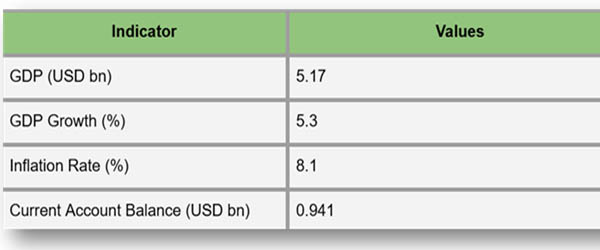
Liberia's weak domestic production capacity and economic structure are directly related to its import activities. Important imports such as machinery, food, and fuel not only demonstrate industry and consumer demand, but also the nation's infrastructure deficiencies. According to Import Globals' Liberia Import Import Data, the current account balance is still negative, meaning that imports continuously exceed exports in value. Nonetheless, the import industry is being supported by port development, foreign investment, and incremental advancements in logistics infrastructure. Even though there is a trade deficit and a financial reliance on foreign partners, the rise in import values over time indicates growing economic activity.
Import Data of Liberia Imports
A greater reliance on imported commodities to satisfy domestic demands is seen in Liberia's import dynamics for 2023 and 2024, especially in vital industries like infrastructure, food, and energy. Liberia's total imports in 2023 were worth about USD 1.945 billion, which was a substantial rise over 2022. According to Liberia Import Trade Analysis, this increasing trend persisted into 2024, when imports are expected to total USD 2.049 billion, pointing to a trajectory of steady expansion in the nation's import activity.
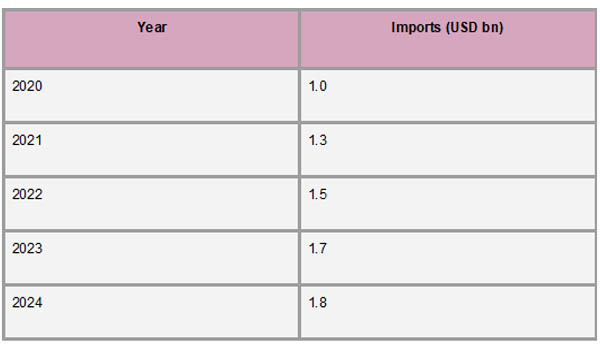
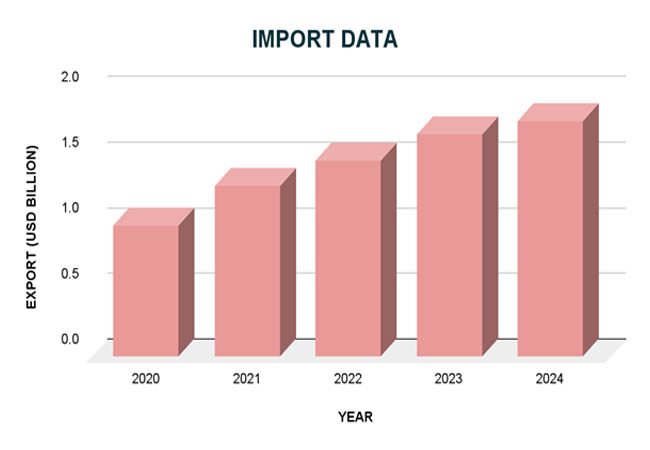
The makeup of Liberia's imports throughout this time frame reveals the country's consumption trends and developmental priorities. Cereals, automobiles, machinery, electrical equipment, and mineral fuels and oils were among the main import categories. These imports are essential for sustaining infrastructure projects, guaranteeing food security, and supplying energy to industry, according to Liberia Export Data From Import Globals. The difficulties Liberia experiences in developing local output and attaining trade balance are further highlighted by the rising import values, underscoring the necessity of strategic economic planning and diversification.
Import Product Categories of Liberia
A growing reliance on imported items to meet domestic demands is seen in Liberia's import panorama for 2023 and 2024, especially in critical areas like infrastructure, food, and energy. Liberia's total imports in 2023 were worth about USD 1.945 billion, which was a substantial rise over 2022. With imports expected to reach USD 2.049 billion in 2024, this rising trend persisted, according to Liberia Import Data From Import Globals, suggesting a steady growth trajectory in the nation's import activity.
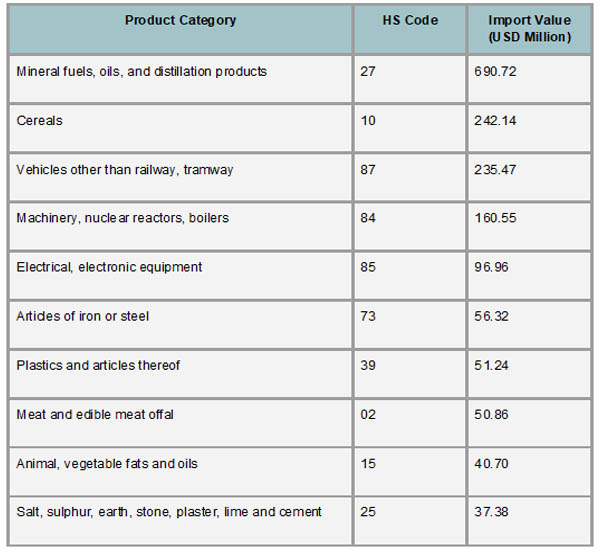
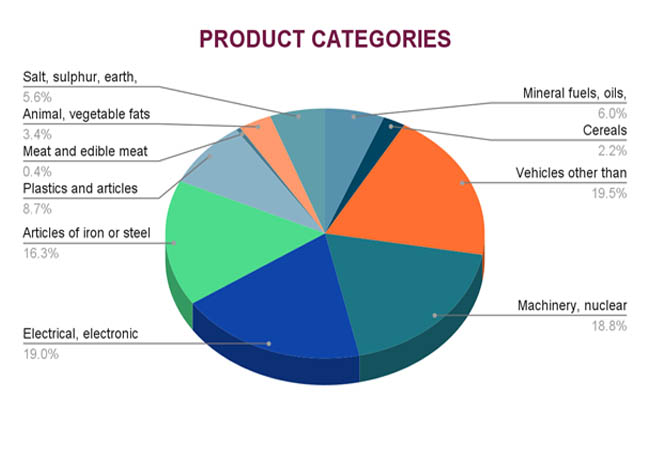
The makeup of Liberia's imports throughout this time frame reveals the country's consumption trends and developmental priorities. Cereals, automobiles, machinery, electrical equipment, and mineral fuels and oils were among the main import categories. These imports are essential for sustaining infrastructure projects, guaranteeing food security, and supplying energy to industry, according to Import Globals' Liberia Import Trade Statistics. The difficulties Liberia experiences in developing local output and attaining trade balance are further highlighted by the rising import values, underscoring the necessity of strategic economic planning and diversification.
Major Import Partners
Significant interaction with a wide range of foreign partners defined Liberia's import environment in 2023. About 30.3% of Liberia's total imports, worth about USD 656 million, come from Côte d'Ivoire, making it the country's top import partner. The import of vital goods like oils and mineral fuels, which are crucial to Liberia's energy sector, is primarily responsible for this robust trading connection. China was the second-largest import partner, accounting for 16.7% (about USD 362 million) of Liberia's import portfolio, according to Liberia Import Shipment Data From Import Globals. It supplied a variety of commodities, such as automobiles, machinery, and electronic equipment.
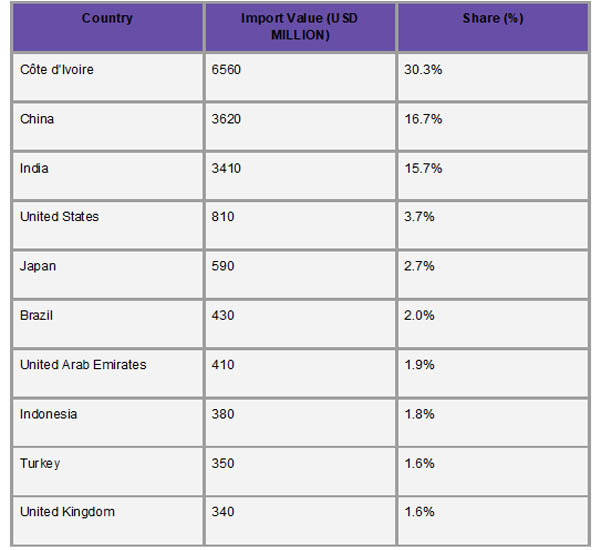
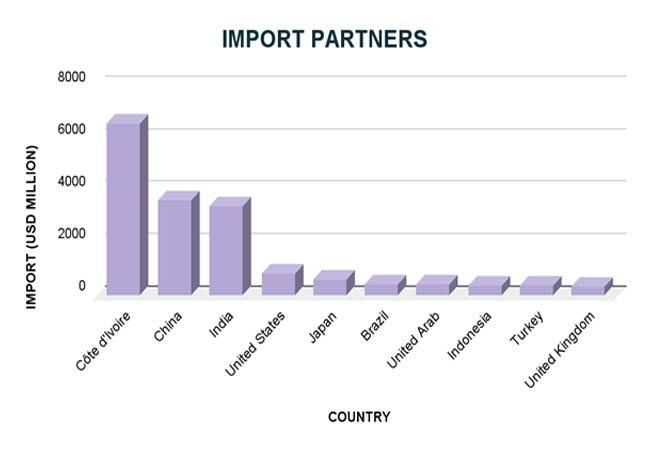
Another significant contributor was India, which accounted for 15.7% of Liberia's imports, worth over USD 341 million. With imports of USD 80.6 million and USD 58.7 million, respectively, the US and Japan made up 3.7% and 2.7% of the total. Brazil, the United Arab Emirates, Indonesia, Turkey, and the United Kingdom were other noteworthy partners; they all contributed a range of products, from industrial machinery to agricultural supplies. This diverse network of import partners highlights Liberia's strategic efforts to engage with numerous economies to meet its domestic requirements and promote its development goals, according to Import Globals' Liberia Import Export Trade Analysis.
Strategic Implications
Significant strategic ramifications for Liberia's economic stability and policy direction result from its growing reliance on imports. The nation is extremely vulnerable to external shocks, including disruptions in the global supply chain, price swings, and currency devaluation, because it relies on imported goods, especially in the areas of energy, food, and industrial equipment. Liberia's trade deficit and foreign exchange reserves are strained by this dependency, which may put additional burden on the country's budget and make it more vulnerable to debt. Furthermore, according to Import Globals' Liberia Export Import Global Trade Data, a strong dependence on a small number of important trading partners, such as China, India, and Côte d'Ivoire, may limit Liberia's negotiating leverage in international trade negotiations and raise geopolitical sensitivities.
Positively, growing local demand, infrastructure advancement, and industrialization initiatives are also reflected in the increase in imports. The importation of construction materials, automobiles, and machinery indicates that Liberia is establishing the framework for capacity building and economic modernization. However, it is strategically essential for Liberia to supplement import activity with programs to increase domestic manufacturing, diversify its economy, and enhance trade logistics to optimize long-term gains. Vulnerabilities could be decreased while promoting sustainable growth by fortifying port infrastructure, streamlining customs processes, and developing trade partnerships with a wider range of nations.
Forecast Trend
Between 2020 and 2024, Liberia's import statistics show a consistent rise in the amount of commodities coming into the nation from abroad, which is a result of both expanding domestic demand and the country's developing infrastructure. Liberia's imports were predicted to be worth USD 1.945 billion in 2023 and USD 2.049 billion in 2024. According to Import Globals' Liberia Import Export Global Data, the importation of vital goods, including machinery, automobiles, cereals, and mineral fuels, all of which are necessary for the country's energy requirements, food security, and infrastructure projects, is primarily responsible for this increasing trend. Liberia's continuous reliance on imported commodities to sustain its economic activities and development objectives is highlighted by the steady increase in import values.
With imports expected to reach USD 2.1 billion in 2025, the forecast indicates that this growth trend will continue. This forecast is in line with the expectation that improvements in the mining industry and rising private consumption will accelerate Liberia's real GDP growth to 5.2% in 2025. The growing import cost, however, is anticipated to exacerbate the current account deficit, which is predicted to rise to 24.6% of GDP in 2025, according to Liberia Importer Data. Strategic economic planning is necessary to improve domestic production capacities, diversify the economy, and reduce potential vulnerabilities brought on by a significant reliance on imports, as this expanding gap makes clear.
Conclusion
In conclusion, Liberia’s import landscape from 2020 to 2024 reflects a nation gradually expanding its economic footprint while still heavily reliant on foreign goods to meet domestic demands. The consistent rise in import values, driven by critical sectors like energy, food, and infrastructure, signifies both growth opportunities and structural vulnerabilities. While key trading partners and diverse product categories support Liberia’s development trajectory, the increasing trade imbalance underscores the urgent need for economic diversification, industrial development, and policy reforms to ensure long-term stability and reduced dependency on external markets.
If you are looking for detailed and up-to-date Liberia Import Data, You Can Contact Import Globals.
FAQs
Que. What are Liberia's top imported products?
Ans. Liberia's top imports include automobile components, bolts with nuts, presenter boxes, and wheel components.
Que. Which countries are Liberia's main import partners?
Ans. China, Japan, Germany, Brazil, and Côte d'Ivoire are among Liberia's primary import partners.
Que. How has Liberia's GDP changed from 2020 to 2024?
Ans. Liberia's GDP has grown from $3.0 billion in 2020 to an estimated $4.75 billion in 2024.
Que. What is the outlook for Liberia's imports in the coming years?
Ans. Imports are expected to rise, driven by infrastructure development and consumer demand, though challenges may affect pricing and availability.
Que. Where can to obtain detailed Liberia Import Data?
Ans. Visit www.importglobals.com or email info@importglobals.com for more information on up-to-date Liberia Import Data.
